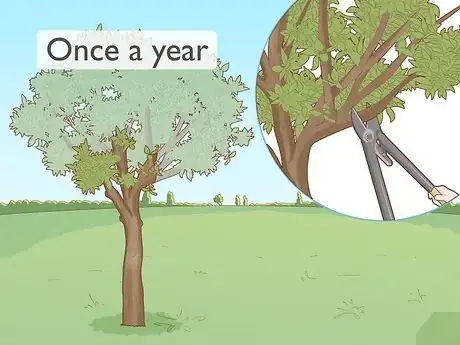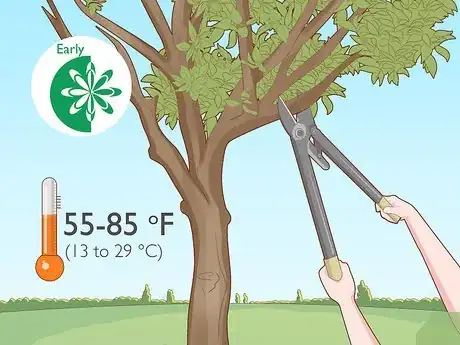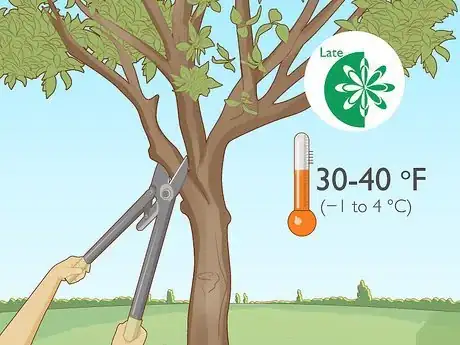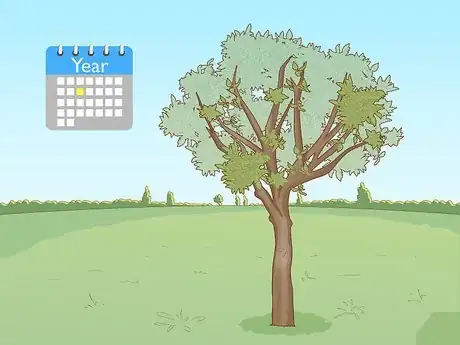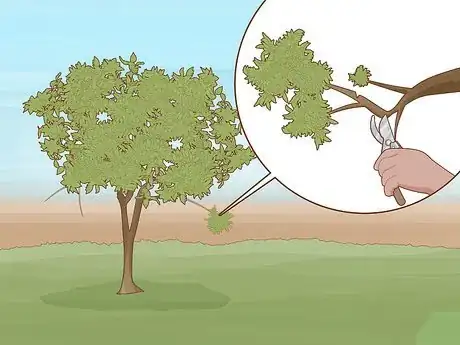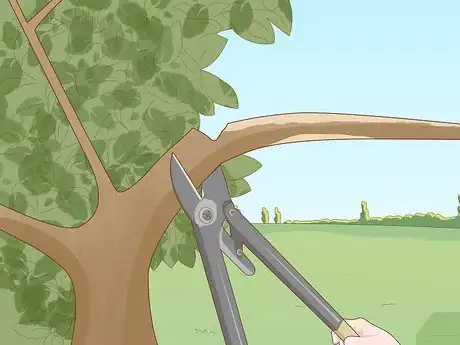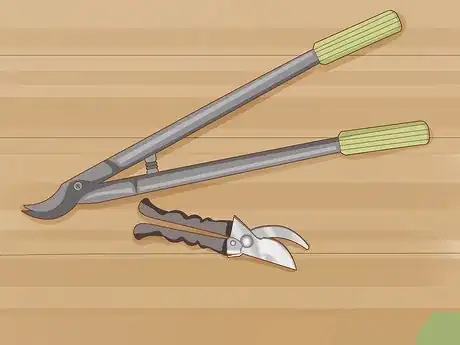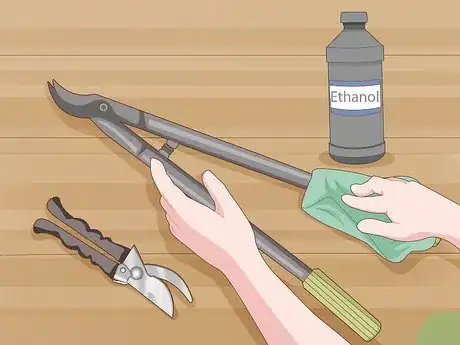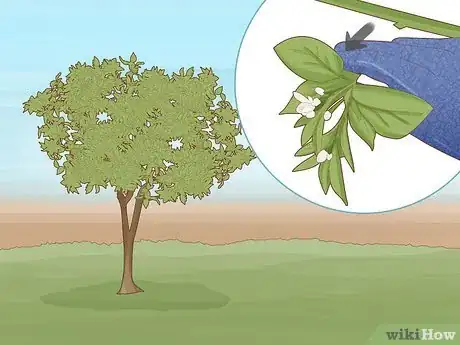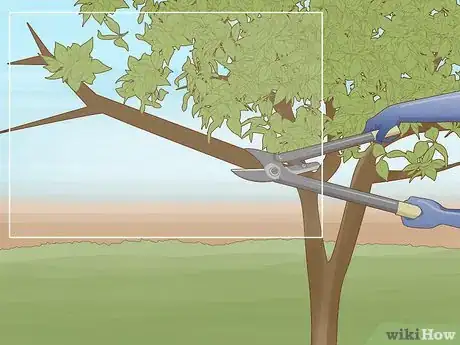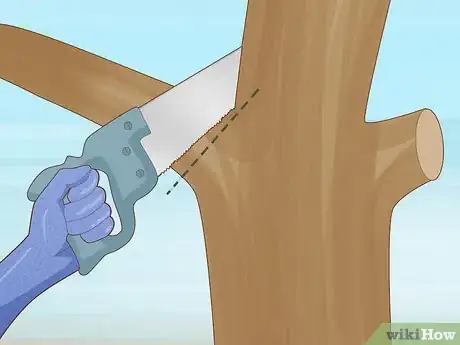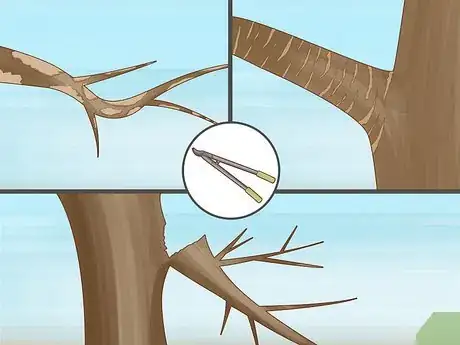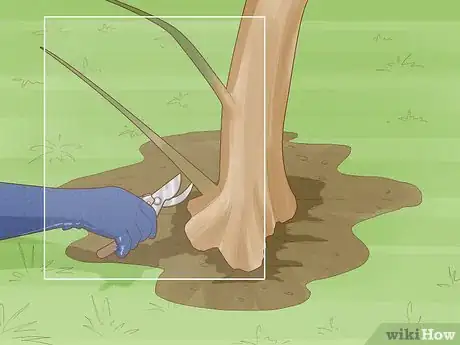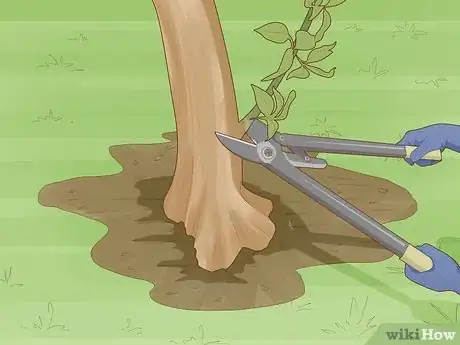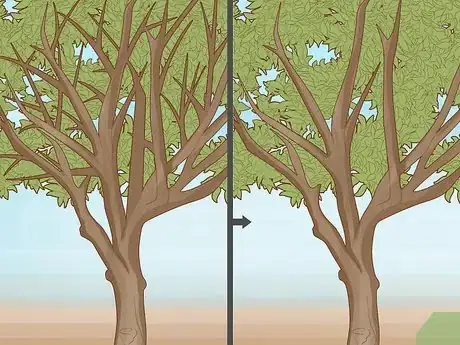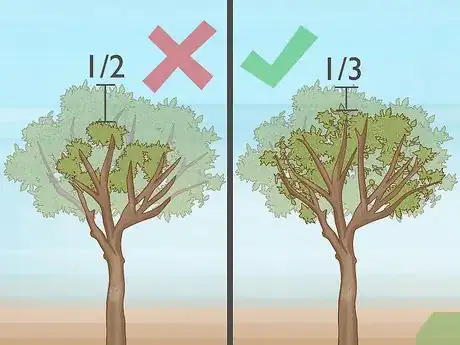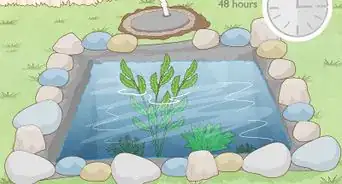This article was co-authored by wikiHow Staff. Our trained team of editors and researchers validate articles for accuracy and comprehensiveness. wikiHow's Content Management Team carefully monitors the work from our editorial staff to ensure that each article is backed by trusted research and meets our high quality standards.
There are 12 references cited in this article, which can be found at the bottom of the page.
This article has been viewed 34,173 times.
Learn more...
Routine trimming keeps orange trees shapely and healthy year-round. Although they don’t require a lot of maintenance, they do benefit from annual pruning in spring. Choose your timing carefully to avoid exposing or damaging the tree. Take the opportunity to eliminate dead, dying, or excessive branches. Cut these branches off close to the trunk with sharp, sterilized shears. Remove no more than 20% of the branches in a season. With proper maintenance, your tree will stay healthy and produce flavorful oranges every year.
Things You Should Know
- You can typically leave your orange trees alone for most of the year, but they will benefit from a single pruning session between February and April.
- When you prune, trim off any dead or dying branches first, and then clip off excessive growth so that you remove no more than 1/3 of the branches.
- When pruning a branch, leave 1–2 inches (2.5–5.1 cm) of the branch where it meets the main trunk to avoid damaging it.
- If you want to increase the amount of fruit that grows, focus your pruning efforts on the branches near the top of the tree; the more horizontal growth you have, the more likely you’ll be to grow a lot of fruit.
Steps
Timing Prunings
-
1Perform heavy pruning once a year. Orange trees mature after 2 to 3 years. At that point, they start producing fruit and become somewhat self-maintaining. Mark a date on your calendar, then give your trees a touch-up around the same time each year. Younger trees need a little extra maintenance and sometimes require trimming several times a year.[1]
- If you have a new orange tree, check it often for vertical shoots and excess branches. Give the tree at least 2 to 4 months to recover from major treatment.
- Damaged and diseased trees could benefit from a second trimming. Be careful to avoid removing too much of the tree, but focus on giving healthy branches ample room to grow.
-
2Trim the trees in early spring if you live in a warm climate. The ideal time to prune orange trees is before they start flowering in spring. Try doing it around February or March. Some growers also choose to prune in the summer or early fall after the trees have dropped their oranges. Plan on pruning in late June if you wish to do it this way.[2]
- Southern California is an example of a warm climate where orange trees grow well. If the weather tends to stay in the 55 to 85 °F (13 to 29 °C) range year-round, consider it a warm climate area.
- If you’re in a warm climate, you have a lot more flexibility when dealing with your trees. The warm weather enables them to grow all year and even produce oranges twice.
Advertisement -
3Cut the trees in late spring if you’re in a cold climate. Frost is a big concern in colder regions. Time out prunings to avoid leaving your trees exposed. Plan on trimming them in late February or March to prepare them for the next growing season. Old leaves and branches will insulate the trees until then.[3]
- Trim the trees once you’re sure the weather will stay above 30 to 40 °F (−1 to 4 °C). Some colder weather is fine, but sustained frost could damage orange trees beyond repair.
-
4Perform light trimming year-round if it is needed. Heavy pruning, like thinning out healthy branches and shoots, should be done once a year to keep orange trees healthy. Gentle maintenance, like trimming the tree’s canopy to keep its shape, can be done at almost any time. If you’re removing large parts of the tree, wait to do it until the spring or fall. Orange trees can generally withstand light trimming at other times.
- If you’re thorough during annual trimming, orange trees likely won’t need much maintenance during the rest of the year. It can be done to shape the tree, however.
- Remove dead or diseased branches as you see them to keep the tree healthy, but don’t thin out healthy branches before your annual pruning session.
-
5Trim young trees to shape throughout the year after removing weak branches. When your tree is less than 10 years old, pruning is meant to help it grow big and strong. Once a year, remove sprouts growing vertically off the stem. Then, carefully thin out the remaining branches to weed out the weak ones. Save the healthiest branches so they have lots of space to continue spreading.[4]
- Tackle the branch problem in the spring before your trees start flowering. Remove the flowers as well if your orange tree is under 2 or 3 years old.
- During the rest of the year, you can maintain the tree with some light trimming. Trim the edges of the canopy to keep the tree’s shape, but don’t remove healthy branches.
-
6Cut older trees cautiously after pruning them once. Trees over 10 years old will have much more growth to take care of each year than younger trees. Annual pruning is about taking care of dead branches and keeping the canopy open so that light can get inside. Remove low or crisscrossing branches, then trim the canopy back into shape. Proper care will encourage more delicious oranges to form on the inner branches.[5]
- Mature trees don’t need much maintenance trimming throughout the year. If you’re doing any trimming, don’t cut too deeply. Avoid removing healthy branches outside of the annual pruning.
Performing Light Pruning
-
1Select sharp shears when pruning orange trees. Loppers, which are pruning shears with long handles, are great for branches up to 2 in (5.1 cm) in diameter. You could switch to one-handed shears called secateurs for smaller branches. Most branches can be taken care of with these tools. With regular maintenance, the branches won’t get big enough to require other tools.[6]
- A lot of smaller branches, including water shoots, can be snapped off by hand.
- For thicker branches, switch to hand pruners or a hacksaw.
-
2Sterilize your pruning tools before using them. Bacteria is ever-present and capable of turning a once-healthy tree into a diseased mess. Always scrub debris off your tools with clean water and a wire brush. Before pruning, dampen a clean cloth in isopropyl alcohol or ethanol. Use it to scrub your blades clean.[7]
- To maximize safety, sterilize your tools after trimming each tree. This isn’t very practical, but you can avoid part of the problem by rotating through several different pruning tools.
-
3Put on protective gear before attempting to prune a tree. Leather gloves are a must no matter how extensively you’re pruning an orange tree. Wear goggles as well to guard against chipped wood and sharp branches. Finish your outfit with a long-sleeved shirt and long pants.[8]
- If you’re using a chainsaw, put on hearing protection to compensate for the noise. Wear a hardhat or helmet to guard against falling branches.
- Stay safe by keeping upper branches at about shoulder-height. Avoid reaching for branches that are higher up than you are.
-
4Cut flowers off of younger orange trees that haven’t matured yet. Snip off every single flower you see sprouting on the branches. Immature orange trees won’t produce oranges, so you won’t lose anything by removing the flowers. Getting rid of them actually helps your tree grow and prepare itself to produce great fruit in the future.[9]
- New orange trees mature after 2 or 3 years of growth. At that point, leave the flowers alone so they turn into oranges.
- Routine pruning on older trees does eliminate some flower buds. However, removing some buds causes the remaining ones to turn into bigger oranges, so it isn’t a problem.
-
5Trim longer branches as needed to keep the tree at a reasonable size. Orange trees don’t require a lot of maintenance, so you won’t have to deal with lots of overgrown branches. However, take a step back and get a good view of the tree. Note any spots that stick out from the rest of the canopy. Trim the ends of these branches to maintain the general shape of the canopy.[10]
- If you’re dealing with space constraints, trim the canopy back on a regular basis to prevent it from overgrowing. Gently trim it every year to maintain the tree’s shape.
- This kind of trimming isn’t strictly necessary, but it’s good for keeping your tree beautiful. Removing dead or excess branches is more important.
Completing Heavy Pruning
-
1Trim branches back to the branch collar instead of the trunk. Check the branches near where they attach to the trunk. Every branch has a swollen spot sticking out from the trunk. Cut branches off in front of this collar to improve your tree’s long-term health. Prune along the collar, taking care not to cut into it.[11]
- Preserving the collar helps the tree heal at a faster rate, which means less chance of disease. Water sprouts are also less likely to grow up from the collars.
- For forking branches, locate the spot where the branches meet. Cut there if you’re planning on preserving one of the branches.
-
2Shear off any branches that are dead or diseased. Dead branches are no longer useful, but diseased branches could pose a threat to your tree. Normal orange branches have a manila color. Diseased branches turn different colors and crack. Rotting branches turn black and should be removed right away.[12]
- Spread open the outer branches to get a glimpse of what is closer to the trunk. Notice anything that looks cracked, splintered, discolored, or broken.
- Note that some discolorations aren’t fatal to your tree, so research the problem before doing any serious pruning. White spots from mildew can be treated with a fungicide. Use a pesticide on spots caused by insects.
-
3Trim any branches that are near to or touching the ground. Some trees, such as mandarin trees, have what are known as skirt branches. These long branches can cause a lot of problems if they aren’t maintained. Prune the branches back so they are at least 2 ft (0.61 m) off the ground. That way, they will be off of the soil and out of your way when you’re working under the tree.[13]
- Fruit and branches that touch the ground collect contaminants that could lead to diseases. They also give insects like ants a way to climb up the tree.
- Many people choose to get rid of the lower branches entirely. It makes the tree look nice, but the downside is that the best oranges often come from those branches and they are hard to regrow.
-
4Eliminate vertical sprouts coming from the trunk and older branches. Water shoots or water sprouts look different than other branches. They are thick and green with big leaves. They tend to grow upward from the bottom of the tree. Since they aren’t very useful, shear them off close to where they connect to the trunk or branch.[14]
- If you let water sprouts grow, they could interfere with other branches. Horizontal branches are much better to keep.
- Some water sprouts can produce oranges, but they are typically not as good as the ones grown on horizontal branches.
-
5Thin out the tree by removing old branches if there is an overabundance. Sometimes, the tree’s branches will grow and come into contact with one another. Find spots where the cross and remove one to give the other more space to grow. Also, look for spots where the branches appear crowded together. Prune a few off so the remaining branches spread and produce better fruit.[15]
- With frequent growth, the tree has more branches than it can support. Removing excess branches keeps your tree healthy and improves the oranges you get from it.
- If your tree is young, it won’t have an overabundance of branches. It happens more often as the tree gets older. Watch more intently once the tree approaches 10 years of growth.
-
6Prune no more than ⅓ of the branches in a year. Keep in mind that orange trees don’t need a ton of maintenance and that too much pruning is harmful. Remember the ⅓ rule, but aim for no more than 20% branch removal during each pruning session. If you’re cautious about what branches you remove, orange trees stay healthy and strong. Removing too many branches could prevent the tree from growing back.[16]
- If the tree is in bad shape, you don’t have as much leeway. Always take down damaged and diseased branches first, then thin out the canopy if you are able to do it without leaving the trunk exposed.
- Bare trees are prone to sunburn just like bare skin is. Trimming off too many branches at once could seriously damage an orange tree.
Things You’ll Need
- Pruning shears
- Cloth
- Water
- Isopropyl alcohol
- Ladder
- Protective glasses
- Leather gardening gloves
- Earplugs or muffs (optional)
- Hardhat or helmet (optional)
References
- ↑ https://gregalder.com/yardposts/when-and-how-to-prune-citrus-trees/
- ↑ https://ucanr.edu/blogs/blogcore/postdetail.cfm?postnum=9428
- ↑ https://extension.arizona.edu/sites/extension.arizona.edu/files/pubs/az1455.pdf
- ↑ https://extension.arizona.edu/sites/extension.arizona.edu/files/pubs/az1455.pdf
- ↑ https://extension.arizona.edu/sites/extension.arizona.edu/files/pubs/az1455.pdf
- ↑ https://ucanr.edu/sites/placernevadasmallfarms/files/134946.pdf
- ↑ https://s3.wp.wsu.edu/uploads/sites/403/2015/03/cloroxed-clippers.pdf
- ↑ https://www.ag.ndsu.edu/publications/lawns-gardens-trees/basic-guidelines-for-pruning-trees-and-shrubs
- ↑ https://www.gardenzeus.com/pruning-citrus-trees-the-why-the-when-and-the-how/
- ↑ https://aggie-horticulture.tamu.edu/citrus/pruning/L2308.htm
- ↑ https://extension.arizona.edu/sites/extension.arizona.edu/files/pubs/az1455.pdf
- ↑ https://howandwhentoprune.com/orange-tree/
- ↑ https://www.agric.wa.gov.au/citrus/citrus-pruning?page=0%2C1
- ↑ https://extension.arizona.edu/sites/extension.arizona.edu/files/pubs/az1455.pdf
- ↑ https://www.gardenguides.com/article-orange-trees.html
- ↑ https://www.youtube.com/watch?v=LtdR9hpu1SE&feature=youtu.be&t=191
